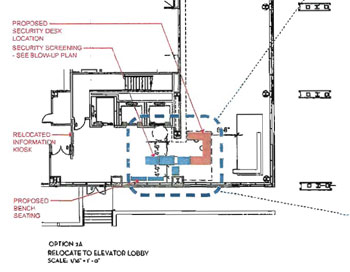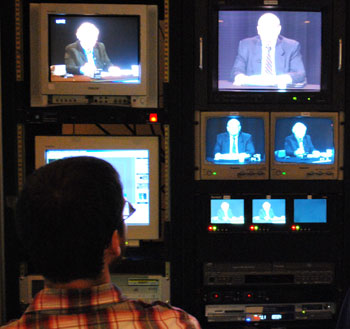Access, Security, and Art at Justice Center
The balance between access and security at the city’s newly constructed Justice Center was part of the agenda for a July 16, 2012 meeting of the Ann Arbor city council’s building committee.

Possible alternate security configuration for Ann Arbor Justice Center. (The orientation of the diagram is with east at the top. Fifth Avenue is at the bottom of the diagram.) Estimated cost of changing to this configuration is about $225,000.
At the meeting, held in the hour before the regular city council meeting at 7 p.m., committee members were briefed on different options for modifying security at the building to improve public access. Currently, visitors to the Justice Center go through a security checkpoint very near the entrance to the building, off the Huron Street plaza. The building houses the 15th District Court as well as the city’s police department.
Among the options committee members were presented is the possible relocation of the airport-style screening station to a position closer to the elevators, on the Fifth Avenue side of the building. Estimated cost for the different options ranges from $30,000 to $225,000.
The work of generating different options came in the wake of concern by some city councilmembers about adequate access to a piece of art they had approved for purchase and installation in the lobby. Councilmembers weren’t content that visitors who wished merely to view the art would have to undergo security screening, and were skeptical that the art would be adequately visible from outside the building through the horizontal bands of etched glass on the Justice Center windows.
That piece of art is a suspended sculpture called “Radius,” by Ed Carpenter. It’s funded through the city’s Percent for Art public art program. Part of the council’s discussion on the artwork back in early May had included a desire to look at options for relocating the security screening checkpoint – and there was an indication that the council’s building committee would convene a meeting to address that possibility. For some councilmembers, there’s a desire to see better public access to the Justice Center lobby independent of the installation of public art there.
At the council’s July 2, 2012 meeting, Jane Lumm (Ward 2) had inquired about the status of the building committee’s meeting. She’d been told by city administrator Steve Powers that the security screening was on the committee’s July 16 agenda.
The committee did not deliberate in depth on the different options – partly because the final invoices and costs for the municipal center building project aren’t final, so it’s not clear if money might remain in the project budget to handle alterations of the security screening station. [The municipal center refers to the Justice Center and adjacent city hall.] Any change to the current security configuration would first be recommended to the full city council by its building committee, with necessary expenditures approved by the city council before implementation by the city administrator.
Councilmembers who attended the July 16 committee meeting included Sandi Smith (Ward 1), Sabra Briere (Ward 1), Margie Teall (Ward 4), and mayor John Hieftje. Staff included city administrator Steve Powers, facilities service unit manager Matt Kulhanek, chief of police John Seto, and CFO Tom Crawford.
After the jump, this article includes more detail on the different security configuration options and the cost breakdown. [Full Story]






